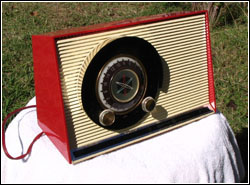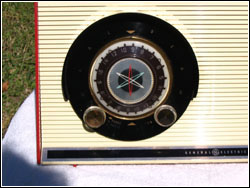Of Old Radios And Related Items--Published Monthly
The General Electric "Atomic"
BY RICHARD ARNOLD
Web Edition
The nostalgia connected to an old radio sometimes comes from sources other than what was once on your family kitchen counter or in your living room. In the case of the GE 862, Richard Arnold's interest could be traced directly to a favorite TV show. (Editor)
About a year or so ago, I started noticing listings for an interesting radio on eBay. Some of the sellers were saying that it was the "Atomic" and the Leave it to Beaver radio. Actually, it was the General Electric Model 862, and one like it was used on the Leave it to Beaver television show. Maybe the sellers were trying to hype a mundane radio by giving it celebrity status.
Well, if so, it certainly worked on me. I started looking for one. I was looking for a set that was in good shape and at a reasonable price. I finally found a GE Model 862 that met all of my requirements, and I purchased it.
Figure 1. The "Atomic" Model 861 in red with ivory grille.The Leave It to Beaver Connection
Since I had always enjoyed Leave it to Beaver over the years, I thought that I would make a point to look for the radio the next time I watched the television program. Well, it took a while to get around to it, but, lo and behold, there it was! It is on the left side of the kitchen sink in the bottom part of a wall cabinet.
Of course, the television program is in black and white, so the actual model number is unknown. The set came in a several colors, each having a different model number according to what color it was.
The Model 860 is a mahogany color, the Model 861 is red, and the Model 862 is turquoise. I later swapped my turquoise 862 for the red 861 shown in Figure 1. Figure 2 (see print version) is a copy of an ad from the Practical Encyclopedia of Good Decorating and Home Improvement showing a Model 862 in turquoise. There is also one with a black cabinet, but I do not know its number. The schematic I have shows only the Models 860, 861, and 862.
Common Characteristics
All of the models share the same plastic cabinet design that has a rear slope to the top of the cabinet. I think this design makes it more interesting and better looking than just a regular square case. They also all have an antique white, front louvered panel. The original power cords are the same color as the cabinets.
One neat thing I like about the radio is the large "Atomic" atom design that is in the center of the tuning dial, as shown in Figure 3. The radio tunes the standard broadcast band from 550-1600 Kc. It also has the Civil Defense markings.
Figure 3. The tuning dial of the Model 861 has the "Atomic" atom design in its center. Note the Civil Defense markings at 640 and 1240 KHz.The dial has an upper dial scale and a duplicate dial scale on the bottom. When you first look at it, you think it has a shortwave band. There is a Type 47 bulb behind the tuning knob that does shine through to light the scale.
The Models 860, 861, and 862 are all 5-tube superheterodynes. They use the following tubes: a 12AU6 converter, a 12BA6 IF amp, a 12AV6 detector and audio amplifier, a 50C5 audio output, and a 35W4 rectifier.
These models use two plastic knobs with gold inserts. The push/pull one on the left side controls power and volume. The knob on the right side is for tuning. There is a phono connection on the rear of the cabinet.
Well, now I have my "Atomic, Leave it to Beaver" radio in a nice shade of red, and I really do like it.
References:
Practical Encyclopedia of Good Decorating and Home Improvement, Vol. 3, p. 490. New York: Greystone Press.
Sams Photofact #374-5
Richard Arnold, a frequent contributor to A.R.C, has been collecting radios since 1985. His interest is primarily in cathedrals and 1920s battery sets, and his collection ranges from crystal sets to a 1929 Bosch in a Pooley cabinet. His prize is the 1932 Jackson Bell Peter Pan featured in the June 1991 A.R.C.
|
[Free Sample] [Books, etc., For Sale] [Subscribe to A.R.C./Renew] [Classified Ads] [Auction Prices] [Event Calendar] [Links] [Home] [Issue Archives] [Book Reviews] [Subscription Information] [A.R.C. FAQ]URL = http://www.antiqueradio.com/Dec08_Arnold_Atomic.html Copyright © 1996-2008 by John V. Terrey - For personal use only. Last revised: November 25, 2008. For Customer Assistance please contact ARC@antiqueradio.com or call (866) 371-0512 toll free Pages designed/maintained by Wayward Fluffy Publications Antique Radio Classified |

